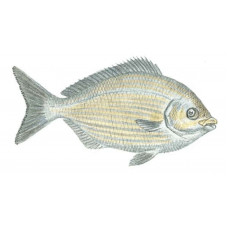Latin name
Kyphosus sectatrix
Other names
Bermuda sea chub; French: calicagère blanche; Spanish: chopa blanca.
Identification
Bermuda Chub has an egg-shaped profile, short head and small mouth. From the edge of the mouth to the edge of the gill cover runs a yellow band bordered in white. The body is compressed and usually steel or bluish-gray in color with muted yellowish stripes. The fins are dusky, the tail forked, and the scales are fringed in blue. It may occasionally have white spots or blotches.
Distribution
Bermuda Chub is found in the western Atlantic Ocean from Massachusetts and Bermuda to Brazil, including the Gulf of Mexico and the Caribbean.
Habitat
Bermuda Chub moves quickly, gathering in large numbers in clear water around tropical reefs, harbors and small boats.
Size
Bermuda chub typically weigh 11⁄2 to 2 pounds and are 10 to 12 inches long. The world record belongs to a fish from Florida, weighing 13 pounds 4 ounces.
Life history and Behavior
No information
Food and feeding habits
It feeds mainly on benthic algae as well as small crabs and mollusks. Because of its small mouth it nibbles on food, anglers consider it a skilled bait thief.
Reproduction
No information
| Classification | |
| Phylum | Chordata |
| Class | Actinopterygii |
| Squad | Perciformes |
| Family | Kyphosidae |
| Genus | Kyphosus |
| Species | K. sectatrix |
| Features | |
| Conservation status | Least Concern |
| Habitat | Littoral |
| Life span, years | No information |
| Maximum body weight, kg | 6 |
| Maximum length, cm | 76 |
| Sailing speed, m/s | No information |
| Threat to people | Edible |
| Way of eating | Omnivore |



